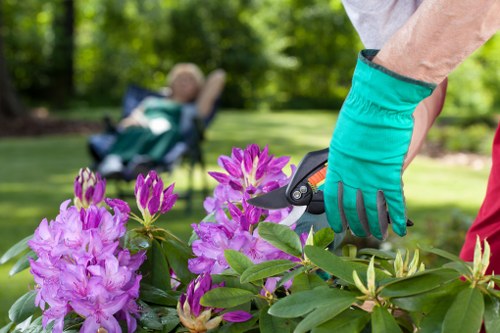Hedge Trimming in Purley: Essential Tips and Professional Services
Understanding the Importance of Hedge Trimming

Maintaining well-trimmed hedges is crucial for the overall health and aesthetics of your garden. In Purley, where gardens play a significant role in residential appeal, regular hedge trimming ensures that your landscape remains tidy and vibrant throughout the year.
Hedge trimming not only enhances the visual appeal of your property but also promotes the healthy growth of your plants. By removing dead or overgrown branches, you allow more light and air to reach the interior of the hedge, fostering robust growth and preventing diseases.
Moreover, well-maintained hedges can act as natural barriers, providing privacy and reducing noise pollution from nearby roads. In a bustling area like Purley, these green barriers are invaluable for creating a peaceful and secluded outdoor space.
When is the Best Time to Trim Your Hedges?

The timing of hedge trimming is essential to ensure the best results. In Purley, the optimal times for trimming hedges are during the late spring and late summer. Trimming in late spring encourages new growth, while late summer trimming helps maintain the shape and health of the hedge as the growing season ends.
Avoid trimming hedges during the winter months or during periods of drought. Cold weather can stress the plants, making them more susceptible to damage, while lack of water can hinder the healing process after trimming.
Additionally, it's important to consider the specific type of hedge you have. Some species may have unique trimming requirements, so consulting with a local gardening expert in Purley can provide tailored advice for your plants.
Essential Tools for Hedge Trimming

Using the right tools is fundamental to achieving a precise and clean trim. For most hedge trimming tasks in Purley, you'll need a combination of manual and powered tools.
Manual Tools: Hedge shears and pruning scissors are ideal for small hedges and detailed work. They offer better control and precision, allowing you to shape your hedges meticulously.
Powered Tools: For larger hedges, powered trimmers or hedge cutters can save time and effort. These tools are especially useful for high or thick hedges, ensuring an even cut without excessive physical strain.
Step-by-Step Guide to Trimming Your Hedges

Trimming hedges requires a systematic approach to ensure health and aesthetics. Here's a step-by-step guide to help you achieve professional-looking results:
- Preparation: Clear the area around the hedge and gather all necessary tools. Ensure your tools are sharp and clean to make precise cuts.
- Initial Trimming: Start by removing any dead or damaged branches. This helps improve airflow and light penetration.
- Shaping: Decide on the desired shape of your hedge. Common shapes include straight, rounded, or angled.
- Cutting: Trim the sides evenly, maintaining a consistent height. It's better to trim a little at a time rather than removing too much at once.
- Finishing Touches: Clean up any stray branches and ensure the hedge is symmetrical and neat.
Hiring Professional Hedge Trimming Services in Purley

While DIY hedge trimming is possible, hiring professional services in Purley can offer numerous benefits. Professional gardeners have the expertise and equipment to handle hedges of all sizes and types efficiently.
Professional services ensure that your hedges are trimmed correctly, promoting their health and longevity. They can also provide additional services such as pest control, fertilization, and overall garden maintenance, ensuring your outdoor space remains beautiful and well-kept.
When choosing a hedge trimming service in Purley, consider their experience, customer reviews, and the range of services they offer. A reputable service will provide a comprehensive approach to garden care, tailored to your specific needs.
Benefits of Regular Hedge Maintenance

Regular hedge maintenance offers multiple advantages beyond aesthetics. Healthy, well-maintained hedges can increase property value, providing a green and attractive feature that appeals to potential buyers.
Additionally, hedges can contribute to environmental benefits such as improved air quality, reduced carbon dioxide levels, and support for local wildlife by providing habitats for birds and insects.
Furthermore, consistent maintenance prevents the need for more extensive and costly repairs in the future. By addressing issues early through regular trimming, you can avoid problems like disease spread or severe overgrowth that can damage your hedges irreparably.
Choosing the Right Type of Hedge for Your Garden

Selecting the appropriate type of hedge is essential for achieving the desired look and functionality in your Purley garden. Different species offer varying textures, colors, and growth habits, allowing you to customize your garden space according to your preferences.
Common hedge types include:
- Boxwood: Dense and evergreen, ideal for formal gardens and precise shaping.
- Privet: Fast-growing and versatile, suitable for creating thick, impenetrable barriers.
- Laurel: Broadleaf and hardy, perfect for creating lush, green screens.
- Holly: Offers beautiful berries and spiky leaves, adding both visual interest and protective qualities.
Consulting with a local horticulturist in Purley can help you choose the best hedge type based on your garden's conditions and your personal preferences.
Common Mistakes to Avoid When Trimming Hedges

Proper hedge trimming requires knowledge and care. Avoiding common mistakes can ensure the health and appearance of your hedges:
- Over-Trimming: Cutting too much can stress the plant and hinder its growth. Stick to trimming only what is necessary to maintain shape and health.
- Trimming at the Wrong Time: Each hedge type has an optimal trimming period. Trimming too late or too early can affect blooming and growth patterns.
- Using Dull Tools: Dull blades can cause uneven cuts, leading to jagged edges that are more susceptible to disease.
- Ignoring Plant Health: Always inspect your hedges for signs of pests or disease before trimming. Addressing these issues beforehand can prevent further damage.
- Neglecting Safety: Always use protective gear and ensure your tools are in good condition to prevent injuries during trimming.
Seasonal Hedge Trimming Tips

Different seasons require different approaches to hedge trimming:
- Spring: Focus on shaping and encouraging new growth after winter dormancy.
- Summer: Perform light trimming to maintain shape and remove any dead or diseased branches.
- Autumn: Prepare your hedges for winter by ensuring they are well-shaped and free from excessive growth.
- Winter: Minimal trimming is recommended; however, removing any broken or diseased branches can prevent damage during harsh weather.
Environmental Considerations for Hedge Trimming

Sustainable practices in hedge trimming can positively impact the environment. Using eco-friendly tools and methods ensures that your garden contributes to a healthier ecosystem.
Consider using electric or battery-powered trimmers to reduce carbon emissions compared to gas-powered alternatives. Additionally, composting trimmed branches and leaves can create valuable organic material for your garden, reducing waste and enriching the soil.
Supporting local biodiversity by maintaining hedges that provide habitats for wildlife helps preserve local species and promotes a balanced garden ecosystem.
Cost-Effective Hedge Trimming Solutions in Purley

Maintaining your hedges doesn't have to break the bank. There are several cost-effective strategies to ensure your hedges remain healthy and attractive:
- Regular Maintenance: Frequent trimming reduces the need for extensive, costly repairs or replacements.
- DIY Trimming: With the right tools and knowledge, you can perform basic trimming tasks yourself, saving on professional service fees.
- Invest in Quality Tools: Durable, high-quality tools may have a higher upfront cost but can save money in the long run by lasting longer and performing better.
- Hire Professionals Selectively: For major trimming tasks or complex shaping, hiring professionals ensures the job is done correctly, preventing costly mistakes.
Enhancing Curb Appeal with Well-Trimmed Hedges

First impressions matter, and your hedges play a significant role in the curb appeal of your Purley home. Well-trimmed hedges create a neat and inviting exterior, enhancing the overall appearance of your property.
Strategically placed hedges can highlight architectural features, define garden boundaries, and create visual interest. Consistent trimming ensures that these features remain prominent and appealing throughout the year.
Moreover, attractive hedges can increase the value of your property, making it more appealing to potential buyers should you decide to sell in the future.
Choosing the Right Hedge Trimmer for Your Needs

Selecting the appropriate hedge trimmer is essential for efficient and effective trimming. There are several types of hedge trimmers available, each suited to different tasks and hedge sizes.
- Manual Hedge Shears: Ideal for small hedges and detailed work, offering precision and control.
- Electric Hedge Trimmers: Lightweight and easy to use for medium-sized hedges, suitable for frequent trimming.
- Gas-Powered Hedge Trimmers: Powerful and suitable for large or thick hedges, providing the necessary strength for extensive trimming tasks.
- Battery-Powered Hedge Trimmers: Offer the convenience of cordless operation without the emissions of gas-powered models.
Consider the size of your hedges, frequency of trimming, and personal comfort when choosing the right tool for your needs.
Safety Tips for Hedge Trimming

Safety should always be a priority when trimming hedges. Adhering to these tips can prevent accidents and ensure a smooth trimming experience:
- Wear Protective Gear: Use gloves, safety glasses, and sturdy footwear to protect against sharp branches and debris.
- Inspect Tools: Before use, check that all tools are in good working condition. Dull blades should be sharpened or replaced.
- Secure Your Area: Clear the trimming area of obstacles and inform others to keep a safe distance.
- Use Proper Techniques: Avoid overreaching and maintain a stable posture to prevent slips and falls.
- Take Breaks: Trimming can be physically demanding. Regular breaks help maintain focus and reduce fatigue.
Maintaining Your Hedge Trimmers

Proper maintenance of your hedge trimming tools extends their lifespan and ensures optimal performance. Here are some maintenance tips:
- Clean After Use: Remove any sap, dirt, or debris from the blades after each trimming session.
- Sharpen Blades: Regularly sharpen the blades to maintain clean cuts and reduce strain on the plants.
- Oil Moving Parts: Apply lubricant to hinges and moving parts to prevent rust and ensure smooth operation.
- Store Properly: Keep your tools in a dry, sheltered area to protect them from the elements.
- Inspect Regularly: Check for signs of wear or damage and replace parts as needed to maintain safety and efficiency.
Eco-Friendly Hedge Trimming Practices

Adopting eco-friendly practices in hedge trimming contributes to a sustainable environment. Here are some ways to trim your hedges responsibly:
Use Sustainable Materials: Choose hedge trimmers and tools made from recyclable or sustainably sourced materials.
Compost Trimmed Branches: Convert green waste from trimming into compost to enhance soil fertility naturally.
Minimize Chemical Use: Opt for natural pest control and fertilization methods to reduce environmental impact.
Integrating Hedges into Your Garden Design

Hedges are versatile elements in garden design, offering both functional and aesthetic benefits. Integrating them thoughtfully can transform your outdoor space:
- Defining Spaces: Use hedges to delineate different areas of your garden, such as pathways, seating areas, or vegetable plots.
- Creating Privacy: Tall, dense hedges serve as effective screens, providing privacy from neighbors and passersby.
- Adding Structure: Well-shaped hedges add structure and formality to your garden design, complementing other plantings and features.
- Enhancing Biodiversity: Diverse hedge species can attract beneficial wildlife, contributing to a balanced and thriving ecosystem.
Common Hedge Problems and Solutions

Even well-maintained hedges can face challenges. Identifying and addressing common problems ensures the longevity and health of your hedges:
- Pests: Insects like aphids and caterpillars can damage hedges. Regular inspections and natural pest control methods can mitigate infestations.
- Diseases: Fungal infections can cause discoloration and wilting. Ensuring proper airflow and avoiding overwatering helps prevent these issues.
- Overgrowth: Neglecting regular trimming leads to unruly hedges that are difficult to manage. Consistent maintenance prevents excessive growth.
- Uneven Growth: Inconsistent trimming can result in uneven shapes. Adhering to a regular trimming schedule ensures uniformity.
Enhancing Hedge Health with Proper Nutrition

Providing your hedges with the right nutrients is essential for their growth and resilience. Here are some tips for maintaining hedge health:
Fertilization: Apply balanced fertilizers in spring and autumn to support robust growth and root development.
Soil Health: Ensure well-draining soil and incorporate organic matter to improve soil texture and fertility.
Watering: While hedges generally require minimal watering, providing adequate moisture during dry periods promotes healthy growth.
Seasonal Care for Your Hedges

Different seasons bring unique challenges and requirements for hedge care:
- Spring: Focus on promoting new growth and shaping your hedges after winter dormancy.
- Summer: Maintain shape and control growth, ensuring hedges are not stressed by heat.
- Autumn: Prepare hedges for winter by ensuring they are well-shaped and free from excessive growth.
- Winter: Protect hedges from harsh weather by avoiding trimming unless necessary for removing damaged branches.
Maximizing Efficiency with the Right Techniques

Using proper trimming techniques enhances both the appearance and health of your hedges. Here are some techniques to maximize efficiency:
Topiary: Artistic trimming to create shapes and designs, adding a unique flair to your garden.
Shearing: Using hedge shears in a systematic manner to achieve a clean, even finish.
Heading Cuts: Removing the top of the hedge to encourage bushier growth and maintain the desired height.
Creating a Trimming Schedule

Establishing a regular trimming schedule ensures that your hedges remain healthy and well-shaped. A consistent schedule helps prevent overgrowth and reduces the workload for each trimming session.
Consider weekly or bi-weekly trims during the peak growing season and monthly trims during slower growth periods. Adjust the frequency based on the specific needs of your hedge type and growth rate.
Having a schedule also allows you to monitor the health of your hedges systematically, making it easier to spot and address any emerging issues promptly.
Integrating Technology in Hedge Trimming

Modern technology offers innovative solutions to simplify hedge trimming tasks:
- Electric Hedge Trimmers: Equipped with adjustable blades and ergonomic designs, they provide greater control and reduce physical strain.
- Battery-Powered Tools: Offer the flexibility of cordless operation, making it easier to navigate larger or more intricate hedges.
- Automated Trimming Systems: Advanced systems can perform precise trims with minimal human intervention, ideal for extensive hedge networks.
Integrating these technologies can enhance efficiency, precision, and overall ease of hedge maintenance.
Eco-Friendly Disposal of Trimmings

Proper disposal of hedge trimmings is vital for maintaining environmental sustainability:
Composting: Turn green waste into nutrient-rich compost, which can be reused in your garden to improve soil health.
Mulching: Use trimmings as mulch to retain soil moisture, suppress weeds, and regulate soil temperature.
Recycling: Some communities offer green waste recycling programs. Check with your local Purley council for available options.
Final Thoughts on Hedge Trimming in Purley

Hedge trimming is an essential aspect of garden maintenance that offers numerous benefits, from enhancing curb appeal to promoting plant health. In Purley, where gardens are a key feature of residential life, keeping your hedges well-trimmed ensures a beautiful and inviting outdoor space.
Whether you choose to undertake hedge trimming yourself or hire professional services, understanding the best practices and proper techniques is crucial for achieving optimal results. Regular maintenance, the right tools, and eco-friendly practices contribute to the longevity and beauty of your hedges.
Don’t wait to transform your garden. Contact us today to schedule your hedge trimming service and keep your Purley garden looking its best all year round.

